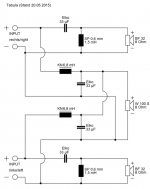Hi All,
I have a question about a 2way crossover I encountered. While looking at the Visaton site, my eye fell on a project for a soundbar (Visaton Tabula). The design uses two small full range speaker and one mid bass driver to make an interesting two-way (or 1,5?) speaker.
My question is, if you look at the design, is this a way to make the mid bass driver a mono channel? See also the crossover attachment.
If indeed mono, does anyone know a location where I can design a similar crossover for my own drivers? I know how to design my own crossovers (sort of) but this mono channel complicates it 🙂
Thanks,
Arjan
I have a question about a 2way crossover I encountered. While looking at the Visaton site, my eye fell on a project for a soundbar (Visaton Tabula). The design uses two small full range speaker and one mid bass driver to make an interesting two-way (or 1,5?) speaker.
My question is, if you look at the design, is this a way to make the mid bass driver a mono channel? See also the crossover attachment.
If indeed mono, does anyone know a location where I can design a similar crossover for my own drivers? I know how to design my own crossovers (sort of) but this mono channel complicates it 🙂
Thanks,
Arjan
Attachments
I agree with PeteMck there. That design looks very poor. The W100S midbass is being driven as mono as it goes. The negative rail is dead shorting the two bridged mode -ve outputs. But it's bad with convention unbalanced line too.
TABULA
At low frequencies, below the point where the crossover has any effect, the two amp outputs on the positive rail are going to be driving each other. In other words seeing a dead short! Voltage amps don't like this. 😕
TABULA
At low frequencies, below the point where the crossover has any effect, the two amp outputs on the positive rail are going to be driving each other. In other words seeing a dead short! Voltage amps don't like this. 😕
Last edited:
last time I saw a schematic like this was back in the 60s, when it was assumed valve OPTs would be driving it, - no problem then... but tempus fugit
Perhaps AC coupling channels of a SS amp would save them, lest their lifetime be measured in milliseconds.
The amplifier will see a dead short at low frequencies whenever the LF shifts to one channel.
I let the smoke out of a receiver in the eary 70's with this kind of circuit.
If the amplifier has a common ground you can run the woofer in series with the ground returns for the HF drivers, then return the woofer to ground. The inductors would then go in parallel with the HF, and the cap in parallel with the woofer.
This technique works best with a 6dB crossover. I did this for a commercial design of a computer sound system about 20 years ago, and also a high-power, high-efficiency sub/sat system (10" 2-way, 98dB and 15" bandpass sub, 102dB).
I let the smoke out of a receiver in the eary 70's with this kind of circuit.
If the amplifier has a common ground you can run the woofer in series with the ground returns for the HF drivers, then return the woofer to ground. The inductors would then go in parallel with the HF, and the cap in parallel with the woofer.
This technique works best with a 6dB crossover. I did this for a commercial design of a computer sound system about 20 years ago, and also a high-power, high-efficiency sub/sat system (10" 2-way, 98dB and 15" bandpass sub, 102dB).
Last edited:
Just use a Monacor instead of a Visaton; Monacor has a catalogue with many double voice coil speakers ( SPH series )
I don't want to defend the circuit, but note that the dcr of the Visaton inductor KN 6.8 mH is 2.8 ohm. Since low frequencies usually are more or less in phase there's a chance the amp doesn't burn that quickly.
Thanks everyone, learned something new about amp bridging and will steer away from using a design like this 🙂
- Status
- Not open for further replies.
- Home
- Loudspeakers
- Multi-Way
- 2 way speaker with mono (?) mid-bass crossover question
